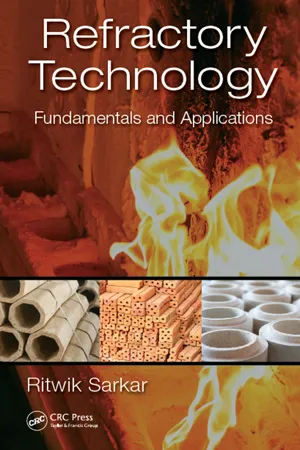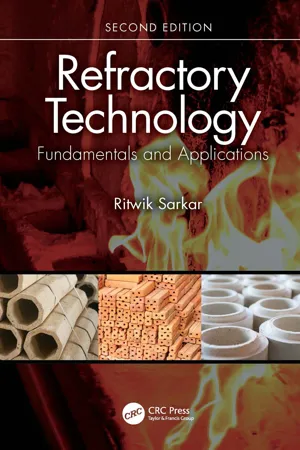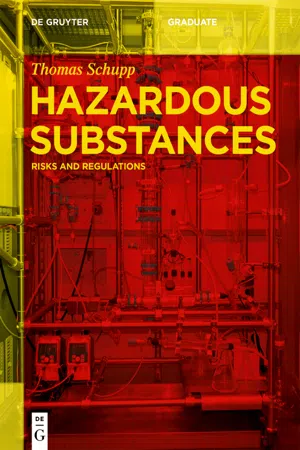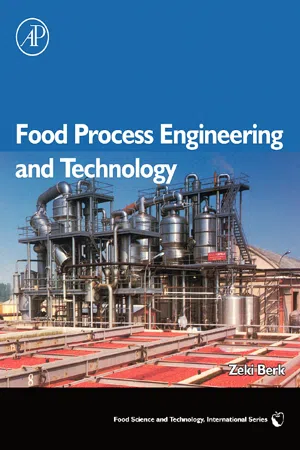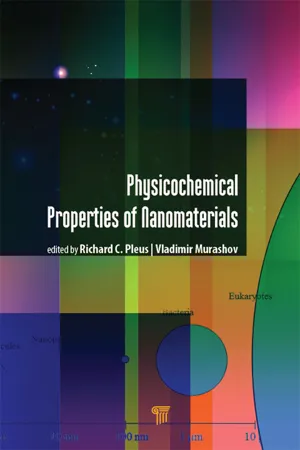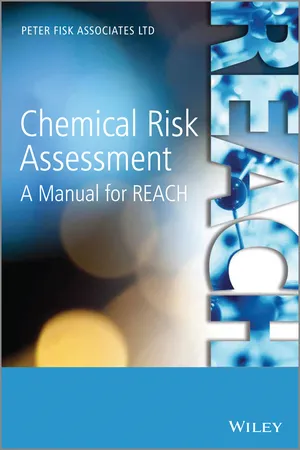Chemistry
Physical Properties
Physical properties refer to the characteristics of a substance that can be observed or measured without changing the substance's chemical composition. These properties include attributes such as color, density, melting point, boiling point, and conductivity. They are used to identify and classify substances and are important in understanding how materials behave under different conditions.
Written by Perlego with AI-assistance
Related key terms
Related key terms
1 of 4
Related key terms
1 of 3
8 Key excerpts on "Physical Properties"
- No longer available |Learn more
Refractory Technology
Fundamentals and Applications
- Ritwik Sarkar(Author)
- 2016(Publication Date)
- CRC Press(Publisher)
There may be different groups of properties that are important for a refractory, and the most common groups of their detailed individual description are given below. Other than the common types of properties like physical, mechanical, and thermal, certain specific properties are also measured for refractories. These refractory-specific properties are also described separately at the end of the chapter.3.2 Physical Properties
Properties that are easily measurable, whose values represent the state of a physical system, and the measurement processes do not change the identity of the material are called Physical Properties. In the measurement of Physical Properties, there should not be any chemical change or mechanical breakdown of the sample, and the physical form should remain intact. Physical Properties can be used to characterize mixtures as well as pure substances. The changes in the Physical Properties of a system can be used to describe its transformations or evolutions between its momentary states.Hence, by definition, physical property is a characteristic of a substance that can be observed or measured without changing its identity. All of the senses can be used to observe the Physical Properties like color, shape, size, etc. Mass, volume, and density are Physical Properties. Changing the mass or volume of a substance does not change the substance’s identity. The state of matter that describes the physical form of the matter is also a physical property.For refractories, the main Physical Properties measured are as follows.3.2.1 Apparent Porosity, Total Porosity, and Bulk Density
The primary difference in manufacturing a metal or glass product and a ceramic product is their processing techniques. Any metal or glass item is made from a material that was in liquid state and processed to a solid state with specific shape and size. The formation of the liquid phase is beneficial as it is free from any air or void space (porosity) inside it, unless and otherwise it is entrapped during processing. But refractories and ceramics are made from loose granular mass having different sized particles and then firing it to a high temperature without or with a little liquid phase formation. Particularly for refractories, the liquid phase formation is nearly negligible (other than fused cast products) as that liquid phase will limit the high-temperature properties and applications of the refractory by a drastic reduction in hot strength. Hence the refractories are sintered in nearly solid state conditions, and the gap between the particles present at green condition (filled with air) are not completely removed (only reduced in size and total volume) even after firing/sintering. - eBook - ePub
Refractory Technology
Fundamentals and Applications
- Ritwik Sarkar(Author)
- 2023(Publication Date)
- CRC Press(Publisher)
There are different groups of properties important for any refractory, and the most common groups and their detailed individual descriptions are given in this chapter. Other than the common types of properties like physical, mechanical, thermal, etc., certain specific properties are measured only for refractories. These refractory-specific properties are also described individually at the end of the chapter.3.2 Physical Properties
Properties that are easily measurable, whose values represent the state of a physical system, and the measurement processes do not change the identity of the material are called Physical Properties. In the measurement of Physical Properties, there must not be any chemical change, mechanical breakdown of the sample and the physical form will remain intact. Physical Properties can be used to characterize mixtures as well as pure substances. The changes in the Physical Properties of a system can be used to describe its transformations or evolutions between its momentary states.Hence, by definition, physical property is a characteristic of a substance that can be observed or measured without changing its identity. All of the senses can be used to observe Physical Properties like color, shape, size, etc. Mass, volume, and density are Physical Properties. Changing the mass or volume of a substance does not change the substance’s identity. The state of matter that describes the physical form of the matter is also a physical property.For refractories, the main Physical Properties measured are as follows.3.2.1 Apparent Porosity (AP), Total Porosity, and Bulk Density (BD)
The primary difference in manufacturing a metal or glass product and a ceramic product is their processing technique. Any metal or glass item is made from its liquid state, and processed to a solid state with specific shape and size. Formation of the liquid phase is beneficial, as it is free from any air or void space (porosity) inside it, unless and otherwise is entrapped during processing. But refractories and ceramics are made up from loose granular mass having different sized particles and then firing it to a high temperature without or with a little liquid phase formation. Particularly for refractories, the liquid phase formation is nearly negligible (other than fused cast products), as that liquid phase will limit the high-temperature properties and applications of the refractory by a drastic reduction in hot strength. - eBook - ePub
Hazardous Substances
Risks and Regulations
- Thomas Schupp(Author)
- 2020(Publication Date)
- De Gruyter(Publisher)
2 Physical and chemical properties of substancesUnderstanding physical and chemical properties of substances is a prerequisite for proper understanding of not only physical–chemical hazards, but also for the understanding of substance behavior in the environment and in organisms.Environmental behavior covers the emission, distribution and fate of a substance in the environment, and this perspective shows similarities to the adsorption, distribution, metabolism and excretion (ADME) of a substance in an organism as discussed in Chapter 3, if an ecosystem (or nature) is regarded as an organism.Physical–chemical properties of substances are part of their identification, and in the field of hazardous substances and risk assessment, proper identification and characterization is crucial for the success of toxicological and environmental investigations. This chapter starts with the identification of substances.2.1 Identification of substances
Identification of a substance starts with simple Physical Properties that can be checked quickly and without sophisticated equipment. For solids, it is the melting point and visual appearance; for liquids, it is the refraction index, perhaps extended to boiling point, viscosity and density. These methods may provide a hint on purity, already, and it may occur that some limited data on identification are sufficient to check the specification of a product agreed upon between supplier and customer. Nevertheless, a more in-depth check on purity or identification of impurities can be very important. Just as one example: the substance aniline was the parent for the name “aniline-cancer,” describing bladder cancer that was comparatively frequently detectable in workforces in aniline production plants. Later, it turned out that impurities in the technical aniline – namely benzidine and 2-naphthylamine – were the causative agents. To detect and quantify such by-products and impurities, spectrometric and chromatographic methods are required. The European chemicals regulation actually requires the full characterization of a “mono-constituent” substance (see Chapter 8) submitted for registration by UV, IR, NMR and MS spectra, as far as appropriate, and to make use of chromatographic methods [gas chromatography (GC), high-performance liquid chromatography (HPLC) and thin-layer chromatography (TLC)] to identify every component that contributes to at least 0.1% to the technical substance. Lower detection limits may be required if the presence of specific critical impurities cannot be excluded. - eBook - ePub
- Zeki Berk(Author)
- 2008(Publication Date)
- Academic Press(Publisher)
Chapter 1. Physical Properties of Food Materials
1.1. Introduction
Dr Alina Szczesniak defined the Physical Properties of foods as ‘those properties that lend themselves to description and quantification by physical rather than chemical means’ (Szczesniak, 1983 ). This seemingly obvious distinction between physical and chemical properties reveals an interesting historical fact. Indeed, until the 1960s, the chemistry and biochemistry of foods were by far the most active areas of food research. The systematic study of the Physical Properties of foods (often considered a distinct scientific discipline called ‘food physics’ or ‘physical chemistry of foods’) is of relatively recent origin.The Physical Properties of foods are of utmost interest to the food engineer, mainly for two reasons:- Many of the characteristics that define the quality (e.g. texture, structure, appearance) and stability (e.g. water activity) of a food product are linked to its Physical Properties
- Quantitative knowledge of many of the Physical Properties, such as thermal conductivity, density, viscosity, specific heat, enthalpy and many others, is essential for the rational design and operation of food processes and for the prediction of the response of foods to processing, distribution and storage conditions. These are sometimes referred to as ‘engineering properties’, although most Physical Properties are significant both from the quality and engineering points of view.
In recent years, the growing interest in the Physical Properties of foods is conspicuously manifested. A number of books and reviews dealing specifically with the subject have been published (e.g. Mohsenin, 1980 ; Peleg and Bagley, 1983 ; Jowitt, 1983 ; Lewis, 1990 ; Rahman, 1995 ; Balint, 2001 ; Scanlon, 2001 ; Sahin and Sumnu, 2006 ; Figura and Teixeira, 2007 - eBook - ePub
- Richard C. Pleus, Vladimir Murashov(Authors)
- 2018(Publication Date)
- Jenny Stanford Publishing(Publisher)
Physicochemical characterization covers a broad spectrum of techniques and methods that aid in probing the interrelationship of chemistry and physical phenomena. The methods range from fundamental studies on subatomic particles to applied methods that probe the collective behavior of molecules, macromolecular, and (larger) particulate systems. For the purpose of this chapter, physicochemical characterization will be focused on molecules and particulate systems and their interaction with and distribution within biotic and abiotic systems. Less attention will be paid to factors resulting in intrinsic physical hazards (e.g., flammability and corrosivity) and chemical reactivity.The physicochemical characterization of chemical substances is an essential part in the journey to understand and predict the impact of molecules and particles for human health and environmental applications. However, ensuring that characterization efforts are suitable and meaningful is not always straightforward due to the vast range of potential measurements, approaches, nuances, and varying interpretations of the data. Because of this, characterization needs to be approached in an interactive manner with careful attention to the necessary detail.Moving from molecular to particulate systems adds complexity, greatly increasing sources of error and uncertainty, in addition to adding to the fundamental considerations. To deconvolute the most practical and meaningful path forward for characterizing the physicochemical properties of materials, an understanding of how the applied methods are confounded by other physicochemical properties and system variables is required, while keeping the overall purpose of the analysis in mind. For this reason, many confounding factors are noted throughout this chapter in order to highlight pertinent uncertainties.3.2 Origins of Physicochemical PropertiesPhysicochemical properties—in both molecules and particles—originate from subatomic processes that give rise to intramolecular charges and electromagnetic fields that ultimately define how molecules and particles interact amongst themselves and with each other. In essence, the majority of relevant physicochemical properties can be attributed to the forces between molecules and between surfaces, either at present or through a series of past events (nonequilibrium processes). For instance, the boiling points (BPs) of liquids can be calculated from charge fluctuation (or van der Waals and hydrogen bonding) forces; and the shape of particles can be understood by following the balance between pertinent molecular interactions versus thermal and shear force histories during particle synthesis. It is important to note that history is an important concept when dealing with the physicochemical characterization of solids and multiphase systems. When processes are not fully reversible—or at least within the time frame of the experiment—then attention to detail on the sequence and content of historical events is often critical. The inability to rely on equilibrium phenomena and the need for explicit attention to phenomena such as order of interaction is a key distinguishing point when attempting to predict the behavior of particles versus molecules. The origin of this phenomena is based on nuances between particles and molecular interactions. - eBook - ePub
Active Pharmaceutical Ingredient Manufacturing
Nondestructive Creation
- Girish K. Malhotra(Author)
- 2022(Publication Date)
- De Gruyter(Publisher)
Tab. 3.1 are of high value, and when used result in process design that will produce quality products. It is not necessary that each of the property mentioned may be needed or used in the design. Properties of raw materials used in production of active pharmaceutical ingredients (APIs), produced intermediates and formulations that may not be commonly available. Their physical property data might have to be generated theoretically and checked experimentally.Tab. 3.1: Chemical and Physical Properties of chemicals [2 ].Physical Properties Chemical properties - Mass
- Density
- Melting/freezing point
- Boiling point
- Viscosity
- Solubility
- Azeotrope
- Heat of formation
- Heat of reaction
- pH
- Surface tension
- Flammability
- Toxicity
- Hygroscopic
Before internet, many trade publications and companies published physical and chemical property data. In 1960s and 1970s, chemical engineering [3 ] and hydrocarbon processing [4 ] magazines published 24 and 44 articles, respectively, about physical and thermodynamic properties of hydrocarbons. Other publications [5 ] detailing Physical Properties are also available. Companies do provide Physical Properties and safe handling procedures [6 ]. Most of this information is available to potential customers only.With the advent of internet, physical and chemical property data can be accessed from these sources [7 , 8 , 9 , 10 ]. Sometimes data needed for specific needs has to be generated by the user in the laboratory.Most companies provide material safety data sheets (MSDS) that meet the regulatory requirements but do not have detailed properties which are needed and used for meaningful and safe process design. If additional information is needed, it might be available if one is a customer. Figure 3.1 shows parts of a typical safety data sheet (SDS) [11 ]. Each supplier has to provide SDS.Fig. 3.1: - eBook - ePub
Chemical Risk Assessment
A Manual for REACH
- Peter Fisk(Author)
- 2013(Publication Date)
- Wiley(Publisher)
Chapter 5
Physico-Chemical Properties for REACH – Purpose and Practicalities
This chapter provides a brief introduction before wider discussion of intrinsic properties in Chapters 6, 7 and 9.5.1 Physico-Chemical Properties
As part of the assessment process, it is necessary to submit certain physico-chemical data on the substance to be registered. The clear understanding of a substance begins with proper and adequate understanding of the substance identity (Section 4.1 and Appendix B of this book) and the physico-chemical properties that are associated with such substance. The information needed depends on the tonnage imported or manufactured in the EU (European Union); however, almost all physico-chemical data are required for substances even at ≥1 tonnes/year (Annex VII). Understanding the physico-chemical properties of a substance helps proper assessment of other endpoints, such as toxicology, environmental fate and exposure assessment, and is essential for ecotoxicology. In some cases it may be useful to conduct prediction to aid understanding, even for properties not required at the Annex level.The basic physico-chemical data endpoints (i.e. types of properties) required at Annex VII of the REACH regulation for all substances are:- Melting point
- Boiling point
- Density
- Granulometry (particle size distribution)
- Vapour pressure
- Octanol–water partition coefficient
- Water solubility
- Surface tension
- Flash point
- Flammability, including pyrophoricity and flammability in contact with water
- Auto-flammability or self-ignition temperature
- Explosive properties
- Oxidising properties.
The information requirement for physico-chemical data can be fulfilled either by the use of available data, by conducting a new study and/or by the use of and appropriate data waiver where relevant. The data should be reliable and scientifically valid. In addition, some of the physico-chemical data can be estimated using a validated (Q)SAR ((Quantitative) Structure-Activity Relationship) prediction method (Sections 5.8 and 5.9 of this chapter). Considerable care is needed with hazardous endpoints such as flash point, which is batch specific, where the result can be influenced by the presence of impurities in the sample. - eBook - ePub
- Gene E. Likens(Author)
- 2010(Publication Date)
- Academic Press(Publisher)
Properties of WaterPassage contains an image
Chemical Properties of Water
J.H. Aldstadt, III; H.A. Bootsma University of Wisconsin-Milwaukee, Milwaukee, WI, USAJ.L. Ammerman SEAL Analytical, Inc., Mequon Technology Center, Mequon, WI, USAWater is H2 O, hydrogen two parts, oxygen one, but there is also a third thing, that makes it water and nobody knows what it is.—D.H. Lawrence (1929)Introduction
Water is the most abundant molecule on Earth. In spite of being so common, water is quite unusual – from its high melting and boiling points to its tremendous solvating power, high surface tension, and the largest dielectric constant of any liquid. In this article, we present an overview of the chemical properties of water. The phrase ‘chemical property’ is context dependent, which we define in general as a description of the way that a substance changes its identity in the formation of other substances. A universally accepted set of chemical properties does not exist in the same way that there is, more or less, a standard set of Physical Properties for a given substance. Whereas a given substance has intrinsic Physical Properties (such as melting point), by our definition chemical properties are clearly tied to change. In addition to reactivity, a substance’s ‘chemical properties’ also typically include its electronegativity, ionization potential, preferred oxidation state(s), coordination behavior, and the types of bonding (e.g., ionic, covalent) in which it participates. Because these properties are extensively studied in general chemistry courses, we will not further discuss them here. Rather, we move beyond the basic general chemistry concepts and focus upon water in a limnologic context – particularly, its bulk fluid structure and aspects of its chemical reactivity in the hydrosphere.In the following pages, we begin by briefly reviewing the molecular structure of water and then discuss models for its structure in ‘bulk’ solution. We then turn our attention to the hydration of ions and an overview of important reactions that involve water, including acid–base, complexation, precipitation, and electron transfer. We conclude with a look at trends in the chemical composition of freshwater that are fundamental to the field of limnology.
Index pages curate the most relevant extracts from our library of academic textbooks. They’ve been created using an in-house natural language model (NLM), each adding context and meaning to key research topics.
Explore more topic indexes
Explore more topic indexes
1 of 6
Explore more topic indexes
1 of 4
